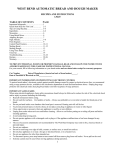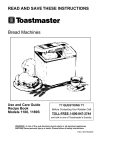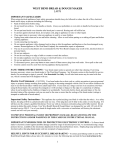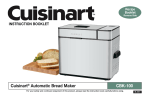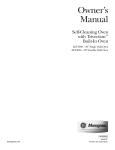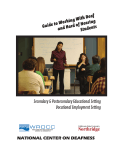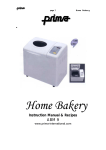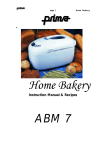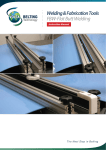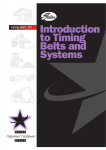Download Toastmaster 1195 Bread Maker User Manual
Transcript
READ AND SAVE THESE INSTRUCTIONS Bread Box™ Bread Maker Use and Care Guide Models 1195 ?? QUESTIONS ?? Before Contacting Your Retailer Call TOLL-FREE 1-800-947-3744 and talk to one of Toastmaster’s Bread Box™ Experts. WARNING: A risk of fire and electrical shock exists in all electrical appliances and may cause personal injury or death. Please follow all safety instructions. IMPORTANT SAFEGUARDS When using electrical appliances, basic safety precautions should always be followed to reduce the risk of fire, electric shock and injury to persons, including the following: • Read all instructions before using the appliance. • To protect against electrical shock do not immerse cord, plug, or appliance in water or other liquid, see instructions for cleaning. • Do not touch hot surfaces. Always use oven mitts when handling the hot bread pan or bread. • This appliance not for use by children. • Unplug the unit from outlet when not in use and before cleaning. Allow to cool before attaching or removing parts. • Avoid touching moving parts. • Do not operate the appliance with a damaged cord or plug or after the appliance m a l f u n c t i o n s, or has been dropped or damaged in any manner. Return the appliance to the nearest author ized service center for examination, repair, electrical or mechanical adjustment. • Do not use outdoors. • Do not let cord hang over edge of the table or counter or touch hot surfaces. • Do not place on or near hot gas or electric burner, or in a heated oven. • To disconnect, grip the plug and pull out from the wall outlet. Never pull on the cord. • Do not use the appliance for other than the intended use. • This product is intended for household use only. • Use accessory attachments only if recommended by Toastmaster Inc. SAVE THESE INSTRUCTIONS THIS PRODUCT FOR HOUSEHOLD USE ONLY Caution: A short power supply cord is provided to reduce the risk of personal injury resulting from becoming entangled in or tripping over a longer cord. Extension cords are available from local hardware stores and may be used if care is exercised in their use. If an extension cord is required, special care and caution is necessary. Also, the cord must be (1) marked with an electrical rating of 125 V., and at least 13 A., 1625 W., and (2) the cord must be arranged so that it will not drape over the countertop or tabletop where it can be pulled on by children or tripped over accidentally. ELECTRIC POWER: If electric circuit is overloaded with other appliances, your breadmaker may not operate properly. BREADMAKER should be operated on a separate electrical circuit from other operating appliances. POLARIZED PLUG: This appliance has a polarized plug (one blade is wider than the other) as a safety feature to reduce the risk of electric shock, this plug is intended to fit in a polarized outlet only one way. If the plug does not fit fully in the outlet, reverse the plug.If it still does not fit, contact a qualified electrician. Do not attempt to defeat this safety feature. 2 BEFORE YOUR FIRST USE Carefully unpack the breadmaker and remove all packaging materials.To remove any dust that may have accumulated during packaging, wipe the bread pan, kneading blade and the outside of the breadmaker with a clean, damp cloth.Do not use harsh or abrasive cleaners on any part of the breadmaker. Warning: Do not immerse the cord, plug, bread pan or base in water or other liquid.Do not use metal scouring pads on any part or parts of the breadmaker because pieces of the pad may break off and touch electrical parts, creating a risk of electric shock. Place the bread machine on a dry, stable surface away from burners and away from areas where cooking grease or water may splatter onto it. After placing the bread pan in the breadmaker, move unit toward back of counter, away from the edge. Plug the breadmaker into a 120 volt 60 Hz AC only outlet. IMPORTANT SAFETY TIPS • Keep the breadmaker out of the reach of infants and children, especially while it is hot.If any control pads are accidentally touched, the operation may stop. • Place the breadmaker at least 2 inches away from any walls. • Do not cover the breadmaker with towels or any other material because steam would not be able to escape. This could cause the lid to warp or change color. • Do not remove the bread pan or insert your hand into the bread pan during operation.If you need to remove the bread pan before operation is complete, first press the STOP pad to stop operation of the breadmaker. • Unplug unit and allow to cool. Remove any flour, bread crumbs or other materials from the inside of the inner case using a damp sponge or cloth or a small, portable vacuum cleaner. • Do not put a larger quantity of ingredients into the bread pan than recommended.If you do so, the bread may not mix or bake correctly and the breadmaker may be damaged. The maximum amount of flour to be used for the BAKE settings is 42⁄3 cups. The maximum amount of packaged bread machine bread mixes is 4 cups. The maximum amount for DOUGH setting is 4 2⁄3 cups flour. • Handle the bread pan with care. Remove the bread pan by pulling straight up on the handle. Do not turn or shake the bread pan while taking it out.If the bread pan is damaged or bent, the temperature sensor won’t work properly. Handle hot bread pan using pot holders or oven mitts. 3 TABLE OF CONTENTS IMPORTANT SAFEGUARDS . . . . . . . . . . . . . . . . . . . . . . . . . . . . . . . . . . . . 2 BEFORE YOUR FIRST USE . . . . . . . . . . . . . . . . . . . . . . . . . . . . . . . . . . . . . 3 IMPORTANT SAFETY TIPS . . . . . . . . . . . . . . . . . . . . . . . . . . . . . . . . . . . . . 3 WELCOME TO THE TOASTMASTER BREAD BOX . . . . . . . . . . . . . . . . . . . 5 MAJOR FEATURES . . . . . . . . . . . . . . . . . . . . . . . . . . . . . . . . . . . . . . . . . . . 5 NAMES AND FUNCTIONS OF PARTS . . . . . . . . . . . . . . . . . . . . . . . . . . . . . 6 CONTROL PANEL NAMES AND OPERATION . . . . . . . . . . . . . . . . . . . . . . . 7 HOWYOUR BREADMAKER WORKS . . . . . . . . . . . . . . . . . . . . . . . . . . . . 8-9 HOW TO USE YOUR BREADMAKER . . . . . . . . . . . . . . . . . . . . . . . . . . 10-12 A. BAKE SETTINGS – IMMEDIATE START . . . . . . . . . . . . . . . . . . 13-14 CUTTING AND STORING BREAD LOVES . . . . . . . . . . . . . . . . . . . 14 B. DOUGH SETTING – IMMEDIATE START . . . . . . . . . . . . . . . . . . . . 15 C. BAKE AND DOUGH SETTINGS – DELAYED FINISH . . . . . . . . 15-16 D. BUTTER CHURN . . . . . . . . . . . . . . . . . . . . . . . . . . . . . . . . . . . . . . 23 BREAD AND DOUGH INGREDIENTS . . . . . . . . . . . . . . . . . . . . . . . . . . 17-22 TROUBLESHOOTING GUIDES . . . . . . . . . . . . . . . . . . . . . . . . . . . . . . . 24-26 PROPER CARE AND CLEANING . . . . . . . . . . . . . . . . . . . . . . . . . . . . . . . . 26 COMMONLY ASKED QUESTIONS . . . . . . . . . . . . . . . . . . . . . . . . . . . . . . . 27 SPECIFICATIONS . . . . . . . . . . . . . . . . . . . . . . . . . . . . . . . . . . . . . . . . . . . 28 LIMITED WARRANTY . . . . . . . . . . . . . . . . . . . . . . . . . . . . . . . . . . . . . . . . . 29 4 WELCOME TO THE TOASTMASTER BREAD BOX Thank you for purchasing your newTOASTMASTER BREAD AND BUTTER MAKER.Your new breadmaker is an exciting appliance because it mixes, kneads and bakes the bread by itself. All you need to do is measure and add the ingredients in the correct order. You can also use the butter churn feature to churn fresh butter from cream in minutes. Please try several loaves of bread from the accompanying Recipe Book to familiarize yourself with the breadmaker, specific breadmaker recipes, and the shape and quality of loaves your breadmaker will make. We recommend White Bread, 100% Whole Wheat Bread, Sticky Breakfast Rolls and Honey Butter, to give you some experience with the different settings. A few things you should know: • The method of using yeast and the order of adding ingredients to the breadmaker and different from yeast bread recipes made from scratch. • The shape of the loaves is different from traditional bread loves. See directions for Cutting and Storing Bread Loaves on page 14. • Accurate measuring of ingredients is very important for best results. • After you try several loaves of bread from the recipes provided, only then should you begin to make any adjustments in the recipe ingredients or try to adapt a favorite family recipe. The more experience you have with the exact ingredient proportions, the more successful you will be when you experiment yourself. Please take time to read the use and care information that follows as well as the information in the Recipe Book that accompanies your breadmaker. By following this information, we feel that you will be thoroughly satisfied, and will enjoy high-quality, delicious fresh bread for years to come ! Major Features Three loaf sizes: 1 pound, 1 ⁄ pounds, and 2 pounds • Remember 1 lb.and 1 ⁄ lb. recipes or mixes will not fill the bread pan when finished. • This is common. Butter churn. • Eight settings for versatility. • Doughbread • Simple setting. for ease of use. • Delayedoperation finish function. • Additional ingredients buzzer. • Automatic keep warm function. • • Glass window for viewing each stage of the selected setting. 1 1 2 2 5 NAMES AND FUNCTIONS OF PARTS When a bread maker is packaged for shipment, a clear plastic film is placed over the control panel as a form of protection.This film may be removed or left on when you begin using your breadmaker. If you do leave it on, it will come off with use. 6 CONTROL PANEL NAMES AND OPERATION Be sure to press the pad until a beep is heard. 7 8 ❏ KNEAD During the first knead, the dough ingredients are mixed together for a few minutes with the kneading blade pulsing on/off. During all knead stages, the dough is m a n i pu l a t e d continuously. Kneading develops the gluten (elastic substance developed from protein when wheat flour is combined with liquid) that gives yeast bread its characteristic cellular structure. ❏ PRE-HEAT For WHOLE WHEAT settings, preheat period occurs at the beginning of the setting to allow time for the liquid to moisten the whole wheat flour and for the breadmaker’s inner case to warm. ❏ RISE The dough is left alone to rise. ❏ PUNCH Releases gas (carbon dioxide) that has built up in the dough. ❏ SHAPE The dough is shaped into a smooth, round ball. ❏ FINAL RISE The dough is left to rise and the bread is formed for baking. ❏ BAKE The buzzer sounds three times when baking is completed. ❏ KEEP WARM The inner case is kept warm automatically to prevent the bread from getting soggy. ❏ BUTTER CHURN The kneading blade churns the heavy whipping cream into butter. The heating element does not warm the inner case . 9 HOW TO USE YOUR BREADMAKER The breadmaker can be programmed to perform various functions. The BAKE settings make bread from start to finish.The DOUGH setting makes dough for a variety of recipes, but you must shape it yourself, then bake it in a regular oven. For the Delayed Finish feature, the breadmaker can be programmed to make bread or dough while you are at work or asleep. For the BUTTER CHURN setting, pour in heavy whipping cream and 30 minutes later you have fresh butter. Before Baking (Use for All Settings) All of the settings are programmed by first following steps 1 through 9 (pages 10 through 12). Then, depending on the setting desired, refer to BAKE SETTINGS- Immediate Start (page 13) DOUGH SETTING- Immediate Start (page 15), or BAKE and DOUGH SETTINGS-Delayed Finish (pages 15 and 16) to complete the process. 1. Choose a recipe from the Toastmaster Recipe Book. Read it thoroughly before you begin to bake. 2. Before adding ingredients, remove the bread pan by pulling the handle straight up. (Adding ingredients outside the breadmaker eliminates the possibility of accidentally spilling ingredients directly into the inner case.). Attach the kneading blade onto the mounting shaft by lining up the flat sides then pushing the kneading blade down onto the mounting shaft. sure all parts are clean and free of crumbs or other food. • Be If the • kneading blade is not placed correctly, kneading may be affected. 3. Select fresh, high-quality ingredients, and use them in proper proportion. Even small adjustments in the type or amount of ingredients can affect the quality of the bread. For BAKE settings, the maximum amount of flour is 4 2⁄ 3 cups. For DOUGH setting, the maximum amount of flour is 42⁄3 cups. For packaged bread machine bread mixes, be sure that the amount of mix is not more than 4 cups. If the amount of mix is more, measure out 4 cups and adjust the yeast and water accordingly. • • • 10 4. Measure accurately for successful breadmaker bread loaves. Mismeasuring, even slightly, can make a big difference in your results. Measure each ingredient precisely before placing it into the bread pan. To measure liquids, use a see-through glass or plastic liquid measuring cup. Measuring Cup Read the measurement at e ye level. • measure flour, spoon into a standard dry • Toingredient measuring cup and level with a straight-edged knife or metal spatula. standard measuring spoons and level with • aUsestraight-edged knife or metal spatula. 5. Measure and add ingredients in the order given in the recipe. Once all ingredients have been added, recheck the recipe to be sure each one was used, and in the correct quantity and order. The correct order of adding ingredients is: 1. Water and other liquids (including eggs) 2. Oil, sugar, salt, etc. 3. Flour and dried fruits 4. Active dry yeast IMPORTANT: When using the Delayed Finish feature, please pay special attention to the order of the ingredients. When adding the dry yeast, make a hollow depression in the mound of flour and pour the dry yeast into it.Do not let the yeast touch the water or the dough may not rise properly. 6. Place the bread pan into the inner case. Wipe off any moisture from the outer side of the bread pan before placing it into the inner case. Make sure the word FRONT on the upper rim of the bread pan is facing toward the front of the breadmaker. Push down on rim until bread pan locks into place. Unless the bread pan is securely placed inside the breadmaker, the bread will not be baked correctly. • • •• 11 7. Close the lid. 8. Plug the breadmaker into a 120 volt 60 Hz AC outlet. When the breadmaker is plugged in, the display window will flash “0 00.” • 9. Select the desired setting. Press the SELECT pad until the number of the desired setting appears in the display windo w. Each time the SELECT pad is pressed, the display window changes to the number of the next setting. • • Amount of baking or churning time 12 A. BAKE Settings-Immediate Start This section explains how to set the breadmaker using one of the various BAKE settings. Make sure that the setting you select is the correct setting for the recipe you are making. Follow steps 1 through 9 on page 10 through 12. 10. Press the START pad. The display window will show the time remaining until the completion of the selected setting.The time will “count down” in one-minute increments. For Example: When you have selected, the Basic (Medium) setting, “2:50” appears in the display window. • BASIC and SWEET Settings: These settings have an additional ingredient buzzer that sounds eight times to allow you to add ingredients such as nuts, raisins, etc. during the last 6 minutes of the kneading.When using delayed start these ingredients are added at the same time as the flour and water, etc. WHOLE WHEAT Settings: For the first 30 minutes of settings number 4, 5 and 6, the breadmaker is preheating and allowing the liquid to moisten the flour. The kneading blade does not mix or knead during this time. The whole wheat rapid preheats for 15 minutes. Note: for all bake settings Steam will rise from the vent on the back of the lid during operation. When baking is finished the buzzer will sound three times and the display will read “0:00”. The colons “0:00” will be flashing, indicating the “Keep Warm” feature is on. When a BAKE setting is complete, the machine automatically goes into a “KEEP WARM” stage. You may remove the bread anytime during this period, or you may wait until the keep warm period is o ver. Note: Unless turned OFF, the “KEEP WARM” feature will remain on 60 minutes after the baking is complete. To turn off the “KEEP WARM” feature, press STOP pad for more than two seconds. The colons “0:00” will stop flashing, but remain in display window. •• •• • 11. Remove the bread pan Open the lid. Using pot holders or o ven mitts, remove the bread pan by pulling straight up on the handle. Caution: Be sure to use pot holders or oven mitts to remove the bread pan as it will be extremely hot! • • 13 12. Remove the bread. Be sure to use pot holders when removing the bread from the bread pan. Turn the bread pan upside down and shake it several times to remove the bread. Place the bread on a wire rack and allow it to cool. The kneading blade may remain in the bottom of the loaf. If this occurs, allow the load to cool, then remove the kneading blade using the bowl end of a plastic spoon or other plastic or wooden utensil so the blade is not scratched. If removing the blade when the bread is hot, use oven mitts or wrap the loaf in a towel. The kneading blade may remain in the bottom of the pan.It is not necessary to remove the kneading blade for cleaning.But if you wish to, it must be removed after each use. To remove, fill the pan with hot soapy water and allow it to soak for 20 minutes. Wash it with a soft brush or cloth and allow to dry thoroughly. • • • • • 13. Unplug the breadmaker When removing the plug, always grasp the plug and not the cord. Cutting and Storing Bread Loaves CUTTING Because loaves baked in a breadmaker are shaped differently from traditional bread loaves, below are several ways to cut them: Use an electric knife for best results when cutting hot bread loaves. Otherwise, a sharp serrated or sawtooth bread knife works well. For square slices-place the loaf on its side and slice across the loaf.We find this is the easiest way to cut loaves. For rectangular slices-place the loaf upright and cut from the top down.Slices may be cut in half, lengthwise or crosswise. For wedges-place the loaf upright and cut through the center from the top down. Place each half cut side down and cut lengthwise into four, six or eight wedges. • • • • STORING If you have leftover bread, store it as follows: Store bread tightly covered at room temperature for up to three days.If weather is hot and humid, store in the freezer. Store bread tightly covered in the freezer for up to one month. Slicing the loaves before freezing makes it easy to use one slice at a time. Do not store bread in the refrigerator because it tends to dry out and become stale more quickly than commercially made bread. Leftover bread can be cut into 1⁄2 or 1-inch cubes for use in your favorite bread pudding, crouton and stuffing recipes. Keep a tightly closed container in the freezer to add to as needed. • • • • 14 B. DOUGH Setting-Immediate Start To set the DOUGH setting: Follow steps 1 through 9 on pages 10 through 12. 10. Press the START pad. The SELECT pad has been pressed, and the machine changed to the “9”- Dough mode. Press the START pad. The remaining time until the dough is finished will be displayed. When the rising is complete, the buzzer will sound three times to let you know the dough is ready. “0:00”will then be displayed. • • • • 11. Remove the dough. When the buzzer sounds, press the STOP pad. Open the lid, remove the bread pan by lifting it straight up and remove the dough. • • 12. Turn the machine off and unplug the cord. Unplug the unit by grasping the plug and not by pulling on the cord. • C. BAKE and DOUGH Settings-Delayed Finish section explains how to set the Delayed Finish feature so that you can ha ve a loaf • ofThisbread or dough whenever you want. using the timer, always set it before pressing the START pad. • When • The Delayed Finish feature can be used to delay the finish of settings up to 12 hours. 15 For example: Let’s say that it is 9:00 pm and you would like a loaf of bread to be finished by 6:30 am the next morning.First, select the Basic (light) Setting by pressing the SELECT pad.The number “1” will appear in the display window. There is a 9 hour, 30 minute difference between 9:00 pm and 6:30 am. So, enter “9:30” (for 9 hours, 30 minutes) by pressing either “¶” or “Ä” pads until “9:30” appears in display window. To program the machine for Delayed Finish: Follow steps 1 through 9 on pages 10-12 for selecting and setting BAKE or DOUGH. To enter 9:30 in the display window, press either the ¶ or Ä pads of the timer set pad. If you press the ¶ pad, 2:40 will appear in the display window. If you press the Ä pad, 2:40 of the Basic (light) setting will appear in the display window. Once more press the Ä pad, 12:00 will appear in the display window. Delayed Finish can be set in 10-minute increments. • • • If you press and “hold” one of the timer set pads, the time will move quickly forward or backward. If you past the time you want to set, press the other pad to reverse the setting to desired time. To check the setting you have selected, press the SELECT pad. To return to the time of the Delayed Finish feature, press the SELECT pad again. • • Press the START pad to start the timer. The colon (:) of the time readout in the display will flash to indicate that the countdown has begun. The display will show the time count-down in one-minute increments until “0:00”has been reached and baking has been completed. If you make a mistake setting the Delayed Finish, press the STOP pad.This will clear the display window and you can begin again. • • • Follow the same directions and precautions for removing the bread pan, turning the machine off, etc., as for any immediate BAKE setting. Follow the recipe for shaping baking, etc. for DOUGH setting. See page 15 for more detailed information. NOTE: The order in which the ingredients are added to the bread pan is critical when using the Delayed Finish feature.The water and yeast must not touch for best results. See page 11. Recipes using eggs, fresh milk, sour cream, cheese, or other foods that could spoil are not recommended for the Delayed Finish feature. For more information see the Recipe Book. Caution: You can program for dough using the Delayed Finish feature. Remove the dough when the cycle is complete. Follow directions for shaping and baking.If you allow the dough to remain in the unit after the cycle is complete, it may overrise and damage the machine. • • 16 Congratulations! You have just acquired a Toastmaster Bread and Butter Maker. Toastmaster Inc. has become a household name you can count on as has RED STAR® Yeast.The Home Economists at RED STAR® Yeast and Toastmaster have combined their efforts to provide the exciting recipes in this cookbook. Many hours of developing and testing these recipes were necessary to assure you, the home baker, a variety of delicious homemade breads.The breadmaker will bake up to a 2 lb. loaf of fresh bread containing approximately 4 cups of flour. While some of you have been baking breads using traditional methods for years, others may have no experience at all. Actually, neither group has an advantage over the other since using a bread machine is a completely new concept in bread making. To achieve optimum results, please take a few minutes and read the following information before you even shop for the ingredients. YEAST: THE NUMBER ONE INGREDIENT RED STAR® Active DryYeast was used in developing all the recipes in this book.However RED STAR® QUICK RISE ™ Yeast could also be used. We found that we did not have to vary the amount used when we substituted one for the other in this Toastmaster Bread Box. Because yeast can grind against itself and become very fine, it is packaged by weight and not by volume. A 1⁄4 oz. package of RED STAR ® Yeast contains approximately 21⁄4 level teaspoons of yeast.The activity of yeast will deteriorate when it is exposed to oxygen, moisture or warmth. Therefore, yeast needs to be stored airtight, refrigerated or frozen. Yeast is granular and comes to room temperature very quickly. Yeast fe rments sugar to leaven bread. White sugar, brown sugar and honey may be i n t e r c h a n g e d equally. Since honey is a liquid, decrease the water by the same amount as the honey added. Artificial sweeteners may not be used as the yeast cannot react with them. But yeast does ha ve the ability to convert the starch in flour to sugar. French bread is an example of yeast activity in a bread dough with little or no sugar. Although sugar is the favorite food of yeast, too much sugar will cause the yeast to dysfunction, especially within a bread machine program.The yeast will have a feeding frenzy and then become lethargic.The loaf of bread will be small and dense. Dried fruits also contribute sugar to the bread dough.Resist the temptation to add more than specified for in the recipe. FLOUR: BREAD FLOUR IS ESSENTIAL All types of flour are affected by a variety of factors, such as milling grades, moisture content, length of storage and manufacturing processes. Adjustments to the recipes may need to be made to compensate for climactic changes in each region to ensure an excellent loaf every time. Bread flour is a definite necessity. Milled from hard winter or spring wheat, it has a higher protein content which makes it more durable than all-purpose flour.The protein, when mixed with liquid, becomes gluten. When kneaded, gluten becomes elastic and give the bread better structure. In contrast, all-purpose flour, milled from a combination of soft and hard wheat becomes elastic too easily for use in a bread machine and quickly loses its ability to stretch well. As a result, bread made from all-purpose flour will be small and dense. Several well-known mills 17 market bread flour. The packages are labeled bread flour and are readily available at grocer y stores. Wheat is the only grain that contains the type of protein that becomes elastic when kneaded. Other flours, such as r ye, barley, oats, soy, rice and buckwheat, add flavor and fiber to breads , but do not add structure to the dough. Therefore, wheat flour is essential as a base when making breads with other flour ingredients. Be careful when adding wheat germ, vegetables, fruits, nuts, and liquid milk to recipes that you do not exceed the amount listed.These products, if used in amounts which exceed the recipe directions, may inhibit the rising of the bread. Vital Wheat Gluten is produced by processing white flour one more step. White flour contains both protein and starch, and mills now can remove most of the starch leaving only the protein (gluten). This is more expensive, but is used only in small amounts as an additive to regular flour. When gluten is added to recipes containing whole grain flours, it improves the volume and shape of the loaf significantly. Usually 1 teaspoon per cup of flour will make a difference. If more than a tablespoon per cup of flour is used, the bread may be tough.Many grocery stores stock gluten in the flour section. Health food stores and nutrition centers also usually carry this item. The addition of soy flour to a bread recipe will give a wonderful nutty flavor as well as add protein, iron, B vitamins, calcium, zinc and dietary fiber. Use the special soy recipe in the recipe section or add soy flour to bread recipes such as white, egg or trail mix.Add up to 1 tablespoon of soy flour per cup of flour to the recipe. No need to adjust other ingredients or change the program. The dough ball will be more tacky than usual, but will bake into a nice loaf of bread. Fore more information on soy products, write or call Missouri Soybean Merchandising Council, PO Box 104778, Jefferson City, Missouri 65110 (573) 635-6701. To measure flour, spoon into measuring cup and level off with a bread knife. DO NOT: tap the cup, pack the flour into cup, or sift the flour. Flour is best kept in an airtight container. If you need to store flour for a long period of time, keep it in an airtight container in the freezer, not the refrigerator. Refrigerators tend to dry out flour. Whole grain wheat flours, which have a higher oil content, will become rancid much more quickly than white flour and should always be kept in the freezer regardless of the length of time you intend to store the flour. Be sure, however, to allow all flour to return to room temperature before placing in the machine. As a good rule of thumb, check the dough ball after the first 5 minutes of the initial kneading cycle. The ball should be round, smooth-textured, soft and slightly tacky to the touch.If it does not form a ball and is more like a batter, add 1 tablespoon of flour at a time until the appropriate consistency is reached.If the mixture is too dry to form a ball or forms more than one ball, add 1 teaspoon of water and allow it to absorb into mixture. Add more water if necessar y. 18 LEMON JUICE: DOUGH ENHANCER Lemon juice contains acidic acid, a natural dough enhancer. The addition of lemon juice (or vinegar - which also contains acidic acid) may help improve the overall structure of your loaf of bread. SALT: REGULATES YEAST ACTIVITY Salt is necessary to control the activity of yeast, disciplining it to work slow and steady. Without salt yeast acts very rapidly and gives out too quickly. Salt also strengthens the structure of the dough. If too little or no salt is used, the bread will rise rapidly and then fall either before the baking or as soon as the baking begins; the texture will be coarse and uneven. Some salt substitutes will work effectively. FAT: DOUGH ENHANCER AND CONDITIONER Shortening is an American term for fat used in recipes. The recipes in this book use vegetable oil. Solid shortening, butter or margarine may be substituted. Divide into small pieces before placing in the machine. There will not be any noticeable flavor difference. The crust may be a little crisper with butter. Margarine tends to make the crust a little tougher. Light or whipped margarine does not work well. LIQUIDS: ACTIVATE THE YEAST AND BIND THE DOUGH Liquids include all the wet ingredients used in the recipe. Traditional bread bakers have been taught correctly that warm liquid (110-115°F) will activate dry yeast. However, when yeast is used in a bread machine, the liquid temperature most likely to provide a good environment for the yeast is 80°F. With this temperature, the yeast activates gradually to accommodate the program of the machine. When higher temperature of liquids are used, the yeast not only activates too quickly, but also the entire dough becomes too warm. If the temperature of the dough rises over 100°F during the rising times, the yeast does not die but becomes very lethargic and is not able to work effectively. Because climates and seasons of the year make for a wide variety of humidity levels, the liquid amount called for in a recipe may have to be adjusted. Flour will not accept the same amount of liquid in a moist humid climate as it will in a dry climate;i.e., Florida residents always use less than Arizona residents. Wisconsin bakers will use less liquid in their machines in the summer than in the winter. The difference may be as much as 1⁄4 to 1⁄2 cup of liquid. When bread is kneading, the dough should be a soft, tacky ball. More flour, one tablespoon at a time, may be added after 5 minutes of kneading if the dough is too wet.More liquid may also be added, one teaspoon at a time, if the dough is too dry. If the bread falls during the baking cycle and/or quite coarse, reduce the total liquid amount. When the machine is set on the delayed timer, reduce the amount of liquid by 1 teaspoon to 2 tablespoons depending on the recipe and size of loaf. Be sure the liquid is very cold. 19 Eggs are also considered part of the total liquid amount. One egg should measure 1⁄4 cup. If it does not, add additional water to equal 1⁄4 cup per egg.An egg white is equal to 1⁄8 cup. If it does not, add additional water to equal 1⁄8 cup. Eggs need to be at room temperature before putting them in the machine. If eggs are taken directly from the refrigerator, place them in a bowl of warm water to take off the chill before cracking. DO NOT USE EGGS WITH THE DELAYED SETTING. Recipes which require nonfat dry milk can be substituted with milk. Omit the dry milk and replace part or all of the water in the recipe with milk. Dry milk, like liquid milk will make the crumb structure have a more velvety texture. Fresh milk is not recommended with the delayed setting. CINNAMON AND GARLIC: NOT TRUE FRIENDS OF YEAST DOUGH Although cinnamon is associated very closely to the nostalgic senses of bread, it has not been a part of the actual dough. Previously, cinnamon and sugar were sprinkled on dough before it was rolled up in a jelly roll fashion. Adding it to the dough in a bread machine presents a problem. Cinnamon acts to bread dough as meat tenderizer acts to meat - breaking down the str ucture. Although it smells wonderful as it is baking, the flavor is dissipated in the baking process. DO NOT ADD MORE than listed in the recipe. Garlic inhibits yeast activity. DO NOT ADD MORE than listed in the recipe. For more garlic flavor use it in a spread for the bread rather than adding it to the dough. BREAD MIXES Use mixes labeled for up to 2 pound loaves. For best results use the No. 1 (Basic LIght) Program. Note: If using the delayed program, reduce the amount of water by 1 tablespoon. Layer ingredients in bread pan in the following sequences: Note: When baking a mix with a high sugar content such as cinnamon, raisin or apple walnut, use the sweet cycle. If additional assistance is needed, expert help is available from Toastmaster (1-800-947-3744) or from RED STAR® YEAST (1-800-445-4746 #4). 20 FREEZING OF BAKED YEAST PRODUCTS: When freezing a baked yeast product, it is important to have it completely cooled before wrapping to prevent moisture from making the product soggy. Do not frost before freezing. Freeze cooled unwrapped product one hour to harden. Remove from freezer; wrap in plastic wrap or aluminum foil.Place in plastic bag and seal.Freeze for up to six to eight weeks.To thaw, partially open wrappings to allow moisture to escape. FREEZING UNBAKED YEAST PRODUCTS: Freezing dough for later shaping and baking is done after the dough is finished kneading and before the first rise. Divide dough into desired amounts and flatten into disks, one-inch thick. Place on cookie sheet and put in freezer one hour to harden. Remove from freezer; wrap with plastic wrap or aluminum foil.Place in plastic bag and seal.Dough can be kept in freezer for up to four weeks.To thaw, place covered dough in refrigerator overnight or for several hours. Place uncovered dough on counter for fifteen to twenty minutes to bring dough to room temperature. Punch down dough.Dough is now ready for shaping and second rising. Dough can also be frozen after being formed into desired shape and before rising. Place shaped dough on cookie sheet; put in freezer one hour to harden.Remove from freezer; wrap with plastic wrap or aluminum foil.Place in plastic bag and seal. Dough can be kept in freezer for up to four weeks. Thaw the covered frozen dough slowly in your refrigerator overnight or for several hours. Bring dough to room temperature partially unwrapped to allow moisture to escape. Let dough rise to double in size before baking.Bake according to recipe instructions. Dough may be frozen for up to six months. If an unbaked product needs to be frozen longer, add one half again as much yeast as called for in recipe. SUBSTITUTES In our test kitchen, we experimented with several ingredient substitutions. We have found the following substitutions to be acceptable, but caution that your results may vary significantly from ours. Milk Coffee Creamer may be substituted for dry milk in equal proportions. Liquid milk may be substituted for water in up to equal proportions. The dry milk may be eliminated altogether. The loaf will be slightly smaller. The crust will be much softer. Lemon Juice Vinegar may be substituted for lemon juice in equal proportions. 21 Sugar One half the amount of sugar will produce both a slightly smaller loaf and a much lighter colored crust. Honey may be substituted for sugar in equal proportions.You will need to reduce the liquid by the same amount of honey you add. Brown sugar may be substituted for white sugar in equal proportions. Yeast NEEDS sugar and so, no artificial sweetener may be used. Salt Salt-free recipes were not successful. Salt substitutes did produce an acceptable loaf. However, the result was somewhat more coarse. Egg Egg beaters may be used as directed on the carton. Two egg whites may be substituted for one egg. REMEMBER all egg products must be room temperature. 22 BUTTER CHURN Most people would agree: it’s hard to beat the taste of homemade bread, served fresh and warm, straight from the breadmaker. But now Toastmaster has created a way to top even that– with freshly churned butter. Although based on the old-fashioned churning method–which used to require a lot of time and elbow grease–making butter in your Bread Box Bread & Butter Maker is now as easy as 1-2-3. Make the butter first, add the additional ingredients, cover tightly and store in the refrigerator. This will allow the flavor of the additional ingredients to enhance the flavor of the butter while your bread is baking. A small amount of butter will be left in the bread pan after scooping out the one half cup of sweet butter. If making bread right away, it is not necessary to wash interior of the bread pan prior to making bread.The bread will absorb the butter during the knead or bake process. Remember, do not immerse the bread pan; refer to the cleaning instructions. Hand wash the lid with mild soap and warm water and dry thoroughly. 1. Make sure your breadmaker and pan are at room temperature. Pour in 1 cup (236 ml) cold heavy whipping cream or heavy cream (contains at least 36% butterfat). Place lid onto bread pan aligning the front mark on the lid with the front of the bread pan. Insert bread pan into breadmaker and close lid. 2. Select butter program (#10). Press start. The machine will churn for 30 minutes. About halfway through the cycle, the mixture may resemble whipped cream. It will then begin to separate. Chunks of butter will be visible and the cream will continue to separate into buttermilk and sweet butter. The breadmaker will beep three times when the cycle is complete. 3. Pour off buttermilk and save for other uses (see Using Buttermilk in the Toastmaster recipe book). To rinse the butter, remove the lid and add 1 cup of cold water to the bread pan. Replace lid, securing tightly on top of pan. Drain water into sink. Repeat rinse procedure again.(This will rinse off any remaining buttermilk and assist in hardening the butter.) Remove butter from pan with a rubber spatula and spread it into a small bowl or butter mold (available at gourmet and kitchen specialty shops). Yield: approximately 1⁄2 cup butter. Cover tightly and store in refrigerator or freezer. See the recipe book for detailed instructions and butter recipes. 23 TROUBLESHOOTING GUIDEBREADMAKER Problem Solution Flour spilled out of bread pan into inner case Unplug unit and allow to cool, wipe out inner case with a clean cloth. Use care when cleaning around heating element. For BAKE setting, use a maximum of 42⁄3 cups flour at a time. For DOUGH setting, use a maximum of 42⁄3 cups flour. Bread not baking properly Check kneading blade mounting shaft for free rotation.If the rotation of the shaft is binding or tight please contact consumer service 1-800-947-3744 for service information. “E:01” appears in display window Open the lid and remo ve the bread pan to cool the inside of the unit. After the panel message disappears, replace the bread pan and press the START pad again. “E:02, E:03, E:04, Unplug the unit and please contact consumer service at E:05, E:08” appears 1-800-947-3744 for service information. in the display window 24 TROUBLESHOOTING GUIDEBREAD LOAVES Problem Not Baked in Center Collapse Causes • Can happen with recipes calling for moist ingredients such as applesauce and yogurt or with heavier flours such as whole wheat or bran. • Reduce the liquids by 1 tablespoon the next time you make the recipe. • Humidity may be high.Add 1 to 2 tablespoons of flour the next time you make the recipe. • Ingredient amounts were out of proportion.Salt omitted. • Too much dough was made. Exceeding the capacity of the bread pan • Over Rising Open or Coarse Texture Heavy, Dense Texture Short Loaf, Unsatisfactory Rising • • • • • • • • • No rise Mushroom-Shaped Top • • • • • • may cause an underbaked, gummy center and a collapsed top. When dough rises to the top of the machine, it interferes with the circulation needed for proper baking and cooling. Warm weather, high humidity or overheated liquids all speed up yeast action, which may cause the dough to rise too fast and the bread to collapse before baking begins. Usually indicates that ingredient quantities are out of proportion. Too much yeast, sugar, flour, liquid or a combination may result in exceeding the capacity of the bread pan. Excess water or yeast was used, or yeast action was accelerated by hot, humid weather or o verheated ingredients. Salt omitted. Not enough water or too much flour was used. Not enough sugar or yeast was used. Recipe was imbalanced by an excess of whole grain flours, whole grains, dried fruits or other added ingredients. Not enough sugar was used. Delayed Finish feature was used and ingredients were placed in bread pan in a w ay that salt or water were in contact with the yeast for a prolonged period. Short, heavier loaves are to be expected when whole grains or whole grain flours are used or when all-purpose flour is substituted for bread flour.Try using bread flour and reducing the amount of other flours and grains. Incorrect amount of yeast was used, or yeast was not fresh. Old or improperly stored yeast was used. Yeast was omitted or mismeasured. Other key ingredients were omitted or mismeasured. Delayed finish feature was used and ingredients were placed in the pan incorrectly. Too much yeast may have been used.Be sure yeast was measured with a teaspoon, not a tablespoon. Added ingredients that contain sugar, such as sweetened applesauce or raisins. 25 Problem Solution Sunken • • Loaf with top or sides that have caved in could be caused by too much moisture. Reduce the liquids by 1 to 2 tablespoons the next time you make the recipe. If recipes call for fruit or vegetables, drain well and pat them dry. SERVICE INFORMATION Please refer to warranty statement to determine if in-warranty service applies. This appliance should be serviced by properly trained appliance repair technicians. Consult your local phone directory yellow pages under “Appliances—Household—Small—Service and Repair” for your nearest Toastmaster authorized service center or call 1-800-947-3744. If an authorized service center is not available locally, your appliance may be returned postage prepaid to our National Service Center at the address shown on the back of this book. Products must be adequately protected to avoid shipping damage for repair or replacement at our option. We suggest you surround your appliance with three inches of protective padding. Please include a note explaining the problem you have experienced—it helps us to properly service your product and speed its return to you.Product must be returned postage prepaid and we recommend insuring your package. PROPER CARE AND CLEANING Unplug the power cord and allow the breadmaker to cool completely. Caution: Do not pour water into the inner case or submerge the breadmaker in water. Use only a mild detergent to clean the breadmaker.To avoid damaging the smooth surfaces of the breadmaker and bread pan, do not use chemical liquid cleaners (such as benzene or thinners), nonabrasive or abrasive cleaners, or scrubbing brushes or pads to clean the breadmaker or bread pan surfaces. The Unit Body, Lid and Inner Case Wipe the outside of the unit body and lid with a damp cloth after each use, Remove any flour, bread crumbs or other materials from the inside of the inner case using a damp sponge or cloth or a small, portable vacuum cleaner. * * •• The Bread Pan and Kneading Blade Both the bread pan and the kneading blade are coated with a nonstick surface. Do not use any cleaners or utensils that could scratch this surface. The nonstick surface may change in appearance after continued use. This is caused by moisture and steam and has no effect on its use or quality. • • 26 the bread pan with kneading blade from the inner case and wipe with a damp • Remove sponge or dish cloth making sure the kneading blade mounting shaft is also very clean. The bread pan interior can be wiped with soapy water, but do not submerge bread pan in water. Clean after each use and dry thoroughly. • Do not soak either part in water or wash in a dishwasher. If it is difficult to remove the kneading blade from the bread pan, fill the bread pan with • warm water and let it stand a few minutes to allow any baked-on bread dough to soften. If the hole in the kneading blade becomes clogged, clean it out with a soft bristle brush or • wooden or plastic toothpicks. Before Storing the Breadmaker Make sure the breadmaker base has cooled completely an all parts have been thoroughly cleaned and dried. Leave the lid open until the breadmaker is completely cool.This will avoid the formation of any moisture in the inner case. • • Any servicing requiring disassembly, other than the above cleaning, should be performed by an authorized service representative. COMMONLY ASKED QUESTIONS What has happened to the kneading blade ? It may have been baked into the bottom of the loaf of bread. See step 12 on page 14 for how to remove the kneading blade from the loaf. Why is bread flour used in most of the recipes ? Bread flour is high in protein.When kneaded the protein produces gluten that gives bread a strong structure more tolerant of variations in the recipe, weather conditions, etc., than allpurpose flour. Can I use all-purpose flour in my breadmaker ? You may use all-purpose flour, however, the bread may be lower in volume and the texture will be slightly different than bread made with bread flour. Because the bread structure is less strong than when bread flour is used, breads made with all-purpose flour are not as tolerant to additional ingredients such as fruit, grains or vegetables. Can I use self-rising flour in my breadmaker ? No, the leavening in self-rising flour interferes with the yeast, and the result will not be satisfactory. What is gluten ? Gluten is the insoluble protein found in wheat flours. Hard wheat has a higher gluten content than soft wheat. Gluten is formed when liquid is added to flour and kneaded. Gluten is the foundation of a good loaf of bread. 27 Can I use my favorite bread recipes in my breadmaker ? You can if you are willing to experiment.Unfortunately, there is no tried-and-true formula for doing this because bread recipes vary.The recipe needs to be scaled down to fit the flour restrictions of your breadmaker (42⁄3 cups for BAKE settings, 42⁄3 cups for DOUGH setting). You will have to figure amounts mathematically. (For example, if a favorite recipe uses 71⁄2 to 8 cups of flour, because your breadmaker has a maximum amount of 42⁄3 cups of flour for baked recipes, you could begin by using 4 cups of flour and one-half of the amount of remaining ingredients.) Use the same order of adding ingredients to the bread pan as recommended in our recipes. Specifications Power source Power consumption Capacity for loaf of bread Timer Outer dimensions (W x D x H) Net weight Accessory 120V. AC Heater 430 W 2.0 lbs Up to 12 hours 133⁄8” x 9 13⁄16” x 13” (340 x 250 x 330 mm) 14.8 lbs (6.7 kg) Recipe Book 28 NOTES NOTES ONE YEAR LIMITED WARRANTY Toastmaster Inc. warrants this product, to original purchaser, for one year from purchase date to be free of defects in material and workmanship. This warranty is the only written or express w arranty given by Toastmaster Inc.This warranty gives you specific legal rights. You may have other rights which vary from state to state. ANY OTHER RIGHT WHICH YOU MAY HAVE, INCLUDING ANY IMPLIED WARRANTY OF MERCHANTABILITY OR FITNESS FOR A PARTICULAR PURPOSE IS LIMITED IN DURATION TO THE DURATION OF THIS WARRANTY. Defective product may be brought or sent (freight prepaid) to an authorized service center listed in the phone book, or to Service Department, Toastmaster Inc.,708 South Missouri St., Macon, MO 63552, for free repair or replacement at our option. Your remedy does not include:cost of inconvenience, damage due to product failure, transportation damages, misuse, abuse, accident or the like, or commercial use.IN NO EVENT SHALL TOASTMASTER INC. BE LIABLE FOR INCIDENTAL OR CONSEQUENTIAL DAMAGES. Some states do not allow limitations on how long an implied warranty lasts, or allow the exclusion or limitation of incidental or consequential damages, so the above limitations or exclusions may not apply to you. For information, write Consumer Claims Manager, at the Macon address. Send name, address, zip, telephone area code and daytime number, model, serial number, and purchase date. KEEP DATED SALES RECEIPT FOR WARRANTY SERVICE. Keep this booklet. Record the following for reference: Date purchased Model number Date code (stamped on bottom of unit National Service Center 708 South Missouri St. Macon, MO 63552 In USA and Canada call: Consumer Service 1-800-947-3744 Consumer Parts 1-800-947-3745 Hours:8:00 a.m. - 4:30 p.m.CST This symbol on the product’s nameplate means it is Listed by UNDERWRITERS LABORATORIES INC. PART NO. 30024A18































